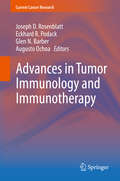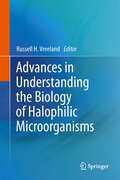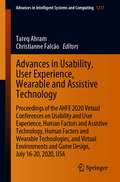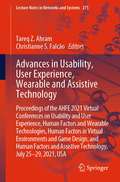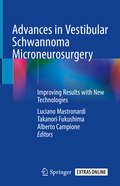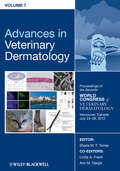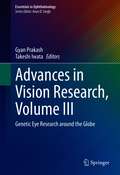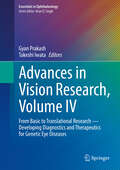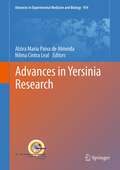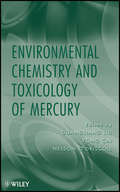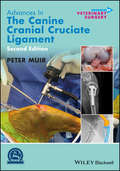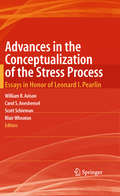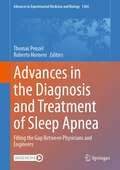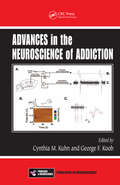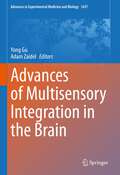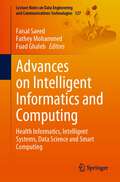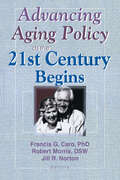- Table View
- List View
Advances in Tumor Immunology and Immunotherapy (Current Cancer Research)
by Joseph D. Rosenblatt Eckhard R. Podack Glen N. Barber Augusto OchoaRecent advances in understanding of fundamental immunology have created new insights into the dynamic interactions between tumors and the immune system. This includes new understanding of T- and B-cell interaction, immune inhibitory mechanisms including the biology of T regulatory cells, myeloid suppressor cells, and dendritic cell subsets. Enhanced understanding of mechanisms underlying T-cell anergy such as arginine deprivation, immunosuppressive cytokines, defective innate and interferon response pathways, and NKG2D downregulation have all provided new insight into suppression of anti-tumor immunity and tumor evasion. In addition to emerging understanding of tumor evasion, new immune targets such as CTLA4 blockade, NK stimulatory receptors, manipulation of the antigen processing and presentation, cytokine and costimulatory responses all provide new possibilities for enhancing anti-tumor immunity even in tumors previously felt to be resistant to immune attack. Several of these strategies have already been realized in the clinic. The volume will explore evolving paradigms in antigen presentation, dendritic cell biology, the innate response and immunosuppressive mechanisms, and emerging strategies for manipulation of the immune system for therapeutic benefit that have realized success in neuroblastoma, leukemia, melanoma, lung cancer, and allogeneic transplantation. Early successes as well as failures will be highlighted to provide a snapshot of the state of clinical immunotherapy with an eye to future possibilities such as combination therapies, adoptive T-cell transfer, and the retargeting of immune cells via T-cell receptor engineering.
Advances in Understanding Kingella kingae (SpringerBriefs in Immunology)
by Joseph W. St. GemeThis book describes the growing body of information on the epidemiology, clinical manifestations, transmission, pathogenesis, diagnosis, and treatment of Kingella kingae infections in young children. In addition, it covers experimental methods that have been developed to study the microbiology, genetics, and virulence factors of K. kingae, information that provides the foundation for new approaches to treatment and prevention of K. kingae disease. With this content in mind, excerpts from the book will be of relevance for clinicians who care for pediatric patients, for clinical microbiologists who are involved in detecting organisms in clinical specimens, and for scientists who are studying K. kingae in an effort to develop novel targets for antimicrobial therapy and new approaches to prevention. First isolated in the 1960s by Elizabeth O. King, a bacteriologist at the CDC, Kingella kingae was largely ignored over the next two decades as a human pathogen because of its uncommon recovery from patients with disease. However, in recent years K. kingae has been increasingly recognized as a clinically important pathogen in young children, and is currently recognized as the leading cause of osteoarticular infections in young children in a growing number of countries. Research into this organism has grown tremendously over the past 15 years, resulting in a better appreciation of the importance of K. kingae in pediatric patients and of the molecular mechanisms of disease.
Advances in Understanding the Biology of Halophilic Microorganisms
by Russell H. VreelandThis book is designed to be a long term career reference. The chapters present modern procedures. This is a how-to-book with a difference. These chapters: - reveal the background information about working with salt loving organisms, - are loaded with information about how experiments are conducted under high salt, - provide information about analyses that work under these conditions and those that may not, - present a wide range of details from laboratory designs to equipment used and even to simple anecdotal hints that can only come from experience. Microbiological training focuses largely on the growth, the handling and the study of the microbes associated with humans and animals. Yet the largest proportion of the Earth's microbiota lives in saline environments such as the Oceans, saline deserts and terminal hypersaline environments. This need for salt can be intimidating for those interested in entering the field or for those interested in understanding how such research is accomplished.
Advances in Usability, User Experience, Wearable and Assistive Technology: Proceedings of the AHFE 2020 Virtual Conferences on Usability and User Experience, Human Factors and Assistive Technology, Human Factors and Wearable Technologies, and Virtual Environments and Game Design, July 16-20, 2020, USA (Advances in Intelligent Systems and Computing #1217)
by Tareq Ahram Christianne FalcãoThis book addresses emerging issues in usability, interface design, human–computer interaction, user experience and assistive technology. It highlights research aimed at understanding human interactions with products, services and systems and focuses on finding effective approaches for improving the user experience. It also discusses key issues in designing and providing assistive devices and services for individuals with disabilities or impairment, offering them support with mobility, communication, positioning, environmental control and daily living. The book covers modeling as well as innovative design concepts, with a special emphasis on user-centered design, and design for specific populations, particularly the elderly. Further topics include virtual reality, digital environments, gaming, heuristic evaluation and forms of device interface feedback (e.g. visual and haptic). Based on the AHFE 2020 Virtual Conference on Usability and User Experience, the AHFE 2020 Virtual Conference on Human Factors and Assistive Technology, the AHFE Virtual Conference on Human Factors and Wearable Technologies, and the AHFE 2020 Virtual Conference on Virtual Environments and Game Design, held on July 16–20, 2020, it provides academics and professionals with an extensive source of information and a timely guide to tools, applications and future challenges in these fields.
Advances in Usability, User Experience, Wearable and Assistive Technology: Proceedings of the AHFE 2021 Virtual Conferences on Usability and User Experience, Human Factors and Wearable Technologies, Human Factors in Virtual Environments and Game Design, and Human Factors and Assistive Technology, July 25-29, 2021, USA (Lecture Notes in Networks and Systems #275)
by Tareq Z. Ahram Christianne S. FalcãoThis book addresses emerging issues in usability, interface design, human–computer interaction, user experience and assistive technology. It highlights research aimed at understanding human interactions with products, services and systems and focuses on finding effective approaches for improving the user experience. It also discusses key issues in designing and providing assistive devices and services for individuals with disabilities or impairment, offering them support with mobility, communication, positioning, environmental control and daily living. The book covers modeling as well as innovative design concepts, with a special emphasis on user-centered design, and design for specific populations, particularly the elderly. Further topics include virtual reality, digital environments, gaming, heuristic evaluation and forms of device interface feedback (e.g. visual and haptic). Based on the AHFE 2021 Conferences on Usability and User Experience, Human Factors and Wearable Technologies, Human Factors in Virtual Environments and Game Design, and Human Factors and Assistive Technology, held virtually on 25–29 July, 2021, from USA, this book provides academics and professionals with an extensive source of information and a timely guide to tools, applications and future challenges in these fields.
Advances in Vagal Afferent Neurobiology (Frontiers in Neuroscience)
by Bradley J. Undem Daniel WeinreichTaking a comprehensive approach in which all aspects of the vagal afferent system are considered, this extensive text reviews the development, neurochemistry, anatomy, biophysics, pharmacology, and physiology of the vagal afferent nerves. The authors present experimental techniques used to investigate the development, morphology, electrophysiology and reflex function of the vagal afferent nerves, and include state-of-the-art reviews of vagal afferent neurobiology by some of the world's leading experts in these fields.
Advances in Vascular Medicine
by Michael Dashwood Gerry Coghlan Clive Handler David AbrahamThere are few books available focusing on translational science in vascular medicine, particularly in the developing field of molecular basis and clinical complications of vascular disease. Advances in Vascular Medicine contains state-of-the-art papers by world experts addressing the key frontier areas of vascular molecular and clinical medicine.
Advances in Vestibular Schwannoma Microneurosurgery: Improving Results With New Technologies
by Luciano Mastronardi Takanori Fukushima Alberto CampioneThis volume describes the most relevant and cutting-edge technological news on the complex surgical procedure of acoustic neuroma. The clinical-radiological diagnosis and surgical indications are briefly presented and the surgical technique is illustrated step-by-step: video clips show the latest means of treating these patients. All these indications were prepared by highly experienced experts in the field, based on their personal experience. The new technologies discussed concern e.g. the intraoperative identification and position of the facial nerve, hearing preservation, techniques for dural closure, and the usefulness of laser and ultrasound aspirators. The book also discusses a number of ongoing projects, including those on: diluted papaverine for microvascular protection of cranial nerves, flexible endoscope for IAC control of tumor removal, fluid cement for bone closure, administering aspirin to control residual tumors larger than 7mm, and DTI for preoperative prediction of the position of the facial nerve. This is a highly informative presented book providing surgeon interested in acoustic neuroma with necessary information on modern technologies available for improving the results of patients.
Advances in Veterinary Dermatology, Proceedings of the Seventh World Congress of Veterinary Dermatology, Vancouver, Canada, July 24-28, 2012
by Sheila M. Torres Linda Frank Ann HargisRepresenting the state of the art of veterinary dermatology around the globe, Advances in Veterinary Dermatology, Volume 7, presents selected scientific papers from the Seventh World Congress of Veterinary Dermatology. The Congress, held in Vancouver, Canada in July 2012, was organized with the support of the World Association for Veterinary Dermatology (WAVD) and its affiliated societies. A record number of delegates attended from over 50 countries to take advantage of the exceptional scientific program. Cutting edge information was presented as review papers and original studies in the areas of:AllergyImmunology Skin Biology TherapyInfectious DiseasesOncologyThese peer-reviewed and edited papers were published in the journal Veterinary Dermatology in volume 24, issue 1, and are included in this hardbound book volume of the conference proceedings. Also included are 13 Workshop Reports which summarise sessions where experts presented topics in various areas providing a wonderful opportunity for colleagues to ask questions and exchange ideas in an informal atmosphere.A vital resource for all practising veterinarians and researchers interested in the field of veterinary dermatology.
Advances in Vision Research, Volume I: Genetic Eye Research in Asia and the Pacific (Essentials in Ophthalmology)
by Gyan Prakash Takeshi IwataThis book presents the state of the art in genetic eye research in Asia and the Pacific. Though there has been an explosion of information on genetic eye research in western countries, more than sixty percent of the human genes involved in eye diseases in the Asian and Pacific population remain unknown. However, new efforts and a new awareness have sparked important discussions on the subject, and new plans are being implemented to discover the genes responsible for many eye diseases in the population. The book reviews the latest findings; its content ranges from genetic aspects of human migration to DNA sequence analysis, genome-wide association analysis, and disease phenotypes. The efforts of the Asian Eye Genetic Consortium (AEGC) are also discussed. The book's editors have been instrumental in developing strategies for discovering the new Asian genes involved in many eye diseases. All chapters were written by leading researchers working on Asian eye genetics from the fields of Human Genetics, Ophthalmology, Molecular Biology, Biochemistry, Sensory Sciences, and Clinical Research. Advances in Vision Research, Volume I will prove to be a major resource for all researchers, clinicians, clinical researchers, and allied eye health professionals with an interest in eye diseases among the Asian population.
Advances in Vision Research, Volume II: Genetic Eye Research In Asia And The Pacific (Essentials In Ophthalmology Ser.)
by Gyan Prakash Takeshi IwataThis second volume continues with a focus on the state of the art in genetic eye research in Asia and the Pacific. Though there has been an explosion of information on genetic eye research in western countries, more than sixty percent of the human genes involved in eye diseases in the Asian and Pacific population remain unknown. However, new efforts and a new awareness have sparked important discussions on the subject, and new plans are being implemented to discover the genes responsible for many eye diseases in the population. The book reviews the latest findings; its content ranges from genetic aspects of human migration to DNA sequence analysis, genome-wide association analysis, and disease phenotypes. The efforts of the Asian Eye Genetic Consortium (AEGC) are also discussed. The book’s editors have been instrumental in developing strategies for discovering the new Asian genes involved in many eye diseases. All chapters were written by leading researchers working on Asian eye genetics from the fields of Human Genetics, Ophthalmology, Molecular Biology, Biochemistry, Sensory Sciences, and Clinical Research. Advances in Vision Research, Volume II will prove to be a major resource for all researchers, clinicians, clinical researchers, and allied eye health professionals with an interest in eye diseases among the Asian population.
Advances in Vision Research, Volume III: Genetic Eye Research around the Globe (Essentials in Ophthalmology)
by Gyan Prakash Takeshi IwataThis third volume, with three supporting editors, broadens its focus on genetic eye research from the Asian to the global scale. New efforts and a new awareness have sparked important discussions on genetic eye research, and new plans are being implemented to identify the genes responsible for numerous eye diseases. The book introduces the latest findings on genetics in eye diseases, gene therapy, and genome-wide association analysis, and the efforts of the Global Eye Genetic Consortium (GEGC). The book’s editors have been instrumental in developing strategies for discovering the new genes involved in many eye diseases. All chapters were written by leading researchers working on eye genetics from the fields of Human Genetics, Ophthalmology, Molecular Biology, Biochemistry, Sensory Sciences, and Clinical Research. Advances in Vision Research, Volume III is a major resource for all researchers, clinicians, clinical researchers, and allied eye health professionals with an interest in eye diseases around the globe.
Advances in Vision Research, Volume IV: From Basic to Translational Research — Developing Diagnostics and Therapeutics for Genetic Eye Diseases (Essentials in Ophthalmology)
by Gyan Prakash Takeshi IwataThis fourth volume in the series Advances in Vision Research describes importance advancements in basics to translational research, including new therapeutics for genetic eye diseases. Recent US FDA approval of the first gene therapy for an inherited retinal disease, due to a mutation in the RPE65 gene, has led to an upsurge in translational eye research. The coverage in this volume includes corneal diseases, myopia, cataract, glaucoma, inherited retinal diseases, inherited optic neuropathy, and other genetic eye diseases. New developments such as the application of artificial intelligence in translational eye research are also discussed. All chapters are written by leading researchers working on eye genetics from the fields of Human Genetics, Ophthalmology, Molecular Biology, Biochemistry, Sensory Sciences, and Clinical Research. Advances in Vision Research, Volume IV will be a major resource for all researchers, clinicians, clinical researchers, andallied eye health professionals with an interest in eye diseases around the globe. The first two volumes in the series described the state of the art in genetic eye research in Asia and the Pacific while the third focused on progress in Europe and the United States.
Advances in Yersinia Research (Advances in Experimental Medicine and Biology #954)
by Alzira Maria de Almeida Nilma Cintra LealThis book is a collection of articles written by prominent scientists who gathered in the city of Recife, Brazil, 23-27 October 2010, celebrating the 10th International Symposium on Yersinia. The event is held every four years in a different country and for the Yersinia 2010, an interesting and updated program covering advances in research in Yersiniae was organized. The major advances achieved over the past four years since the last symposium held in Lexington, USA in 2006 were divided into eight chapters: Epidemiology, Clinical, Diagnostic and Therapeutic aspects; Ecology and Modeling; Genomic/Transcriptomics and Large Scale Population; Immune Response and Vaccine; Pathogenesis and Pathogenicity Factors; Cellular Yersiniology; Bacterial Structure and Metabolism: Roles in Pathogenesis and Bacterial Life Style. The purpose of the book is to extend cutting edge knowledge on Yersinia discussed during the 10th International Symposium.
Advances in environmental chemistry and toxicology of mercury
by Guangliang Liu Yong Cai Nelson O'DriscollThe book that looks at mercury's impact on the planet today Recent research by the EPA has concluded that one in six women of childbearing age have unsafe levels of mercury in their bodies, which puts 630,000 newborn babies each year at risk of neurological impairment. Mercury poses severe risks to the health of animals and ecosystems around the world, and this book provides the essential information that anyone interested in environmental sciences should know about the fundamentals of the entire mercury cycle. Comprised of four parts that present an overview of mercury in the environment, mercury transformations, transport, and bioaccumulation and toxicology, each chapter of Environmental Chemistry and Toxicology of Mercury includes the basic concepts of the targeted subject, a critical review of that subject, and the future research needs. This book explains the environmental behavior and toxicological effects of mercury on humans and other organisms, and provides a baseline for what is known and what uncertainties remain in respect to mercury cycling. The chapters focus on the fundamental science underlying the environmental chemistry and fate of mercury. This work will be invaluable to a wide range of policy experts, environmental scientists, and other people requiring a comprehensive source for the state of the science in this field.
Advances in the Assessment of Dietary Intake.
by Dale A. Schoeller M. WesterterpDiet is a major factor in health and disease. Controlled, long-term studies in humans are impractical, and investigators have utilized long-term epidemiological investigations to study the contributions of diet to the human condition. Such studies, while valuable, have often been limited by contradictory findings; a limitation secondary to systematic errors in traditional self-reported dietary assessment tools that limit the percentage of variances in diseases explained by diet. New approaches are available to help overcome these limitations, and Advances in the Assessment of Dietary Intake is focused on these advances in an effort to provide more accurate dietary data to understand human health. Chapters cover the benefits and limitations of traditional self-report tools; strategies for improving the validity of dietary recall and food recording methods; objective methods to assess food and nutrient intake; assessment of timing and meal patterns using glucose sensors; and physical activity patterns using validated accelerometers. Advances in the Assessment of Dietary Intake describes new avenues to investigate the role of diet in human health and serves as the most up-to-date reference and teaching tool for these methods that will improve the accuracy of dietary assessment and lay the ground work for future studies.
Advances in the Canine Cranial Cruciate Ligament
by Peter MuirAdvances in the Canine Cranial Cruciate Ligament, Second Edition presents in-depth, focused, and updated coverage of current knowledge on cruciate ligament rupture, using a multidisciplinary, evidence-based approach. Presents a state-of-the-art summary of the most recent knowledge on this important cause of lameness in dogs Led by a highly respected surgeon and researcher, with chapters written by leading experts in the field Provides an update to the groundbreaking first edition, with six new chapters
Advances in the Characterisation and Remediation of Sites Contaminated with Petroleum Hydrocarbons (Environmental Contamination Remediation and Management)
by Ravi Naidu Jonás García-Rincón Evangelos Gatsios Robert J. Lenhard Estella A. AtekwanaThis open access book synthesizes important advances in the assessment and management of soil and groundwater systems contaminated with petroleum hydrocarbons, especially in the form of light non-aqueous phase liquids (LNAPLs). LNAPL characterization and remediation is challenging due to the multi-phase, multi-component nature of the problem and the various physical, chemical, and biological processes involved in a dynamic and heterogeneous hydrogeological setting. This book focuses on the current state of practice of LNAPL characterization and remediation and seeks to provide information and a framework that would allow some of these complexities to be better addressed by contaminated land practitioners, researchers, and regulators.
Advances in the Conceptualization of the Stress Process: Essays in Honor of Leonard I. Pearlin
by William R. Avison Scott Schieman Blair Wheaton Carol S. AneshenselThe stress process paradigm has been one of the most dominant conceptual models of health and illness over the past three decades. The contributions to this volume chart a new course for the stress process, extending the paradigm conceptually, methodologically, and substantively. Written in honor of Leonard I. Pearlin, the leading proponent of the stress process, the contributions to this volume provide a new direction for stress process research. Featuring contributions from leading researchers, and an afterword by Leonard I. Pearlin, this comprehensive volume covers three major sections: -Conceptual and methodological extensions of the stress process -The roles of family and work in the stress process, throughout the life course - Psychosocial factors that impact health outcomes. This volume will be an invaluable resource for researchers in sociology, social psychology and public health, all seeking to understand the pervasive role of stress on social disparities in health and illness.
Advances in the Diagnosis and Treatment of Sleep Apnea: Filling the Gap Between Physicians and Engineers (Advances in Experimental Medicine and Biology #1384)
by Thomas Penzel Roberto HorneroThe book focuses on biomedical innovations related to the diagnosis and treatment of sleep apnea. The latest diagnostic tools are described, including sleep laboratory equipment, wearables, and even smartphone apps. Innovative medical devices for treatment are also covered, such as CPAP, Auto-PAP, hypoglossal nerve stimulation, phrenic nerve stimulation, acoustic brain stimulation and electrical brain stimulation. This is an ideal book for biomedical engineers, pneumologists, neurologists, cardiologists, physiologists, ENT physicians, pediatrics, and epidemiologists who are interested in learning about the latest technologies in treating and diagnosing sleep apnea.
Advances in the Neuroscience of Addiction (Frontiers in Neuroscience)
by George F. Koob Cynthia M. KuhnUnderstanding the phenomenon of long-lasting vulnerability to addiction is essential to developing successful treatments. Written by an international team of authorities in their respective fields, Advances in the Neuroscience of Addiction provides an excellent overview of the available and emerging approaches used to investigate the biologic mechanisms of drug addiction. It also delineates the promising research discoveries being made in relapse prevention.The book begins with current animal models of addiction, which mimic the state of humans entering treatment: recently-abstinent animals that receive common triggers for relapse (classical conditioning, stress, and neuroadaptive dysregulation). Coverage then shifts to the use of electrophysiologic approaches, which enable researchers to characterize the discharge patterns of single neurons during drug self-administration. After exploring advances in voltammetry and enzyme-linked biosensors for measuring glutamate, the book discusses the theoretical background and results of neuroimaging studies related to neuronal networks that are activated by drug-specific cues. It then describes modern genetic approaches to manipulate target proteins that influence addictive behavior.The book rounds out its coverage by illustrating how a neuroeconomic approach can inform studies of reward processing in general and addiction in particular. It is a comprehensive introduction to the methodologies of the field for students and beginning researchers and an essential reference source for established investigators.
Advances of Multisensory Integration in the Brain (Advances in Experimental Medicine and Biology #1437)
by Yong Gu Adam ZaidelThis book presents the latest research on multisensory brain function. Namely, the mechanisms by which the brain processes and integrates information from multiple sensory modalities. Its contents cover a broad range of topics, including optimal integration, cross-modal interactions, calibration, and causal inference – with an emphasis on their neuronal underpinnings. By bringing together efforts from different laboratories around the world we aim to collaboratively shed light on these fundamental brain processes, that underlie perception, cognition, and behavior in a complex multisensory world, and to spur innovation of brain-inspired technologies
Advances on Intelligent Informatics and Computing: Health Informatics, Intelligent Systems, Data Science and Smart Computing (Lecture Notes on Data Engineering and Communications Technologies #127)
by Faisal Saeed Fathey Mohammed Fuad GhalebThis book presents emerging trends in intelligent computing and informatics. This book presents the papers included in the proceedings of the 6th International Conference of Reliable Information and Communication Technology 2021 (IRICT 2021) that was held virtually, on Dec. 22-23, 2021. The main theme of the book is “Advances on Intelligent Informatics and Computing”. A total of 87 papers were submitted to the conference, but only 66 papers were accepted and published in this book. The book presents several hot research topics which include health informatics, artificial intelligence, soft computing, data science, big data analytics, Internet of Things (IoT), intelligent communication systems, cybersecurity, and information systems.
Advancing Aging Policy as the 21st Century Begins
by Francis G Caro Robert Morris *Deceased* Jill NortonBy the end of the current decade, many baby boomers will be senior citizens. What policies should we enact to prepare for an aging society?In the coming decade, we have a unique opportunity to create new and better aging policies. This collection of twenty essays by prominent educators, researchers, and policy analysts in the field of gerontology brings together innovative ideas from the United States, Europe, and Japan. Instead of focusing on utopian dreams, these exciting proposals are based on policy changes that may well be attainable in the next ten years. The vital concerns addressed in Advancing Aging Policy as the 21st Century Begins include work and retirement issues, the aging prison population, long-term care, Latino elders, transportation, death and dying issues, and the aging of the baby boom generation. Advancing Aging Policy as the 21st Century Begins explores: innovative policies and care arrangements around the world the importance of a strong economy that provides opportunities for seniors who seek them and support for those who need it the need for flexible retirement and employment policies for older adults the connections between family policy and aging policy the importance of improving training and compensation for workers in long-term care the special needs of our diverse and rapidly growing population of older people the importance of focusing aging policy on people rather than on programsThis forward-looking book on policy and aging in the coming decade puts the experience and insight of leaders in the field from around the world in your hands. Policymakers, educators, and students of gerontology will find it an invaluable resource.
Advancing Biotechnology: Technological Advancements in Biosciences and Biotechnology (Advances in Science, Technology & Innovation)
by Vibha Rani Bhawna Saxena Neha AtaleThis book offers the authors to share their opinion, news, research, reviews, and ideas on different aspects of biotechnology such as medical, plant biotechnology, food biotechnology, bioinformatic applications, systems biology, and biomedical engineering. World has witnessed the potential impact of biotechnology in various sectors. The ever-evolving nature of biotechnology and bioinformatics has resulted in an exponential increase in biotech entrepreneurship, industry-wide innovation, and development of novel technologies. Additionally, computational advancements including artificial intelligence, next generation sequencing, big data approaches, and complex algorithms have opened opportunities to understand the complex mechanisms and cellular behavior. The utility of this field has been appreciated worldwide; therefore, evaluating its applications, advancements, possibilities, challenges, ethics, and multidimensional utility will benefit scientific and non-scientific community for future applications.
